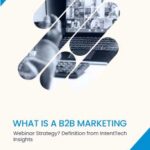or call: +1 (845) 347-8894

or call: +1 (845) 347-8894
or call: +1 (845) 347-8894

What if your next software investment solved real problems instead of just checking boxes? In today’s rush toward digital transformation, many businesses chase cloud solutions without fully understanding what they need or what their users expect. The result? Bloated tech stacks, frustrated teams, and disappointing ROI. Intent-based SaaS adoption flips this script by starting with one essential question: What is the purpose behind the purchase?
This article explores how aligning cloud decisions with actual business needs and user behavior can lead to smarter, leaner, and more impactful technology choices.
Every modern enterprise feels the pressure to evolve digitally. Cloud adoption is no longer a trend; it’s a requirement. But not all SaaS (Software as a Service) solutions are created equal. The challenge isn’t choosing a cloud platform—it’s selecting one that aligns with intent. What does your team need, and more importantly, why do they need it? Welcome to the realm of intent-based SaaS adoption, where decisions are driven by business function, user behavior, and goal alignment.
Too often, cloud migration happens in haste. Companies chase market standards or replicate competitor models. This results in mismatched tools, low adoption rates, and wasted budget. Intent-based SaaS adoption flips this script. Instead of asking, “What’s popular?” the right question becomes: “What does my team actually want to achieve?”
Intent data offers insight into:
Aligning software choices with these signals ensures that each solution has a defined purpose, not just a purchase order.
To choose the right SaaS platform, you need to decode three layers of intent:
Only when all three types of intent are understood can cloud selection move from reactive to strategic.
To assess cloud tools based on intent, it’s crucial to consider three key layers. Each layer brings a distinct perspective, helping you evaluate the solution from different angles. These layers are:
Each solution must check all three boxes to qualify as intent-aligned.
Intent-based selection also reveals where customization is essential and where standard tools will suffice. Not every business need requires a bespoke platform. Some goals are served well by off-the-shelf cloud apps, while others demand tailored workflows.
Key considerations include:
By linking intent to flexibility, decision-makers can avoid overengineering while ensuring adaptability.
Monitoring user behavior, feedback, and adoption rates provides real-time intent cues. Watch for these signals:
Each signal tells a story about misaligned tools or misunderstood workflows. With intent-driven tracking, fixes become targeted and proactive, not reactive and expensive.
Consider a SaaS company managing global marketing operations. Leadership wants improved campaign visibility across teams. The initial response? Buy an enterprise-wide cloud marketing suite.
However, functional intent shows regional teams use different data sets, and user intent reveals most users prefer localized tools. The correct solution isn’t one massive platform. Instead, it’s a set of lighter, interoperable tools with unified dashboards.
This kind of clarity only emerges when intent precedes procurement.
Without intent-based planning, companies face:
These aren’t small oversights, they’re strategic failures. Avoidance begins with clarity.
Cloud tools should grow with your business, not just exist beside it.
Every cloud decision your business makes should begin with a question: “What are we trying to fix?” Intent-based SaaS adoption is not just a framework—it’s a mindset. It ensures that you are not buying software, but investing in solutions that reflect your goals, respect your users, and respond to your needs.
At IntentTech Insights™, we believe in strategic clarity. That’s why we advocate for choices rooted in behavior, business purpose, and outcome, not just technology. Make your SaaS decisions smarter. Let intent lead.
It’s the process of selecting cloud solutions based on the actual needs, behaviors, and goals of users and business units, rather than following trends or vendor marketing.
Through analytics (usage data), feedback forms, interviews, help desk tickets, and surveys that highlight where friction or need exists.
CRMs with analytics, customer experience platforms, and feedback management tools help identify real usage patterns.
Ideally, every quarter or during major organizational changes to ensure solutions should be aligned with evolving goals.
Aligning SaaS tools with intent ensures higher adoption, better ROI, improved scalability, and fewer redundant platforms. It transforms software investments into strategic enablers rather than cost centers.
To participate in our interviews, please write to our IntentTech Media Room at sudipto@intentamplify.com
